Key Figures
- 45 press releases & highlights
- 23 media
Precise tuning of interlayer electronic coupling in layered conductive metal-organic frameworks
 Electrically conductive metal-organic frameworks (MOFs), such as two-dimensional conjugated MOFs (2D c-MOFs), have attracted increasing interests for (opto)-electronics and spintronics. They generally consist of van der Waals stacked layers and exhibit layer-depended electronic properties. While considerable efforts have been made to regulate the charge transport within a layer, precise control of electronic coupling between layers has not yet been achieved. The researchers from the group of Prof. Xinliang Feng report a novel strategy to precisely tune interlayer charge transport in 2D c-MOFs via side-chain induced control of the layer spacing. They design hexaiminotriindole ligands allowing programmed functionalization with tailored alkyl chains (HATI_CX, X = 1,3,4; X refers to the carbon numbers of the alkyl chains) for the synthesis of semiconducting Ni3(HATI_CX)2. The layer spacing of these MOFs can be precisely varied from 3.40 to 3.70 Å, leading to the widened band gap, suppressed carrier mobilities, and significant improvement of the Seebeck coefficient. With this demonstration, we further achieve a record-high thermoelectric power factor of 68 ± 3 nW m−1 K−2 in Ni3(HATI_C3)2, superior to the reported holes-dominated MOFs.
Electrically conductive metal-organic frameworks (MOFs), such as two-dimensional conjugated MOFs (2D c-MOFs), have attracted increasing interests for (opto)-electronics and spintronics. They generally consist of van der Waals stacked layers and exhibit layer-depended electronic properties. While considerable efforts have been made to regulate the charge transport within a layer, precise control of electronic coupling between layers has not yet been achieved. The researchers from the group of Prof. Xinliang Feng report a novel strategy to precisely tune interlayer charge transport in 2D c-MOFs via side-chain induced control of the layer spacing. They design hexaiminotriindole ligands allowing programmed functionalization with tailored alkyl chains (HATI_CX, X = 1,3,4; X refers to the carbon numbers of the alkyl chains) for the synthesis of semiconducting Ni3(HATI_CX)2. The layer spacing of these MOFs can be precisely varied from 3.40 to 3.70 Å, leading to the widened band gap, suppressed carrier mobilities, and significant improvement of the Seebeck coefficient. With this demonstration, we further achieve a record-high thermoelectric power factor of 68 ± 3 nW m−1 K−2 in Ni3(HATI_C3)2, superior to the reported holes-dominated MOFs.
Watching how a covalent polymer develops using a scanning tunneling microscope
Highlight in Phys.org.
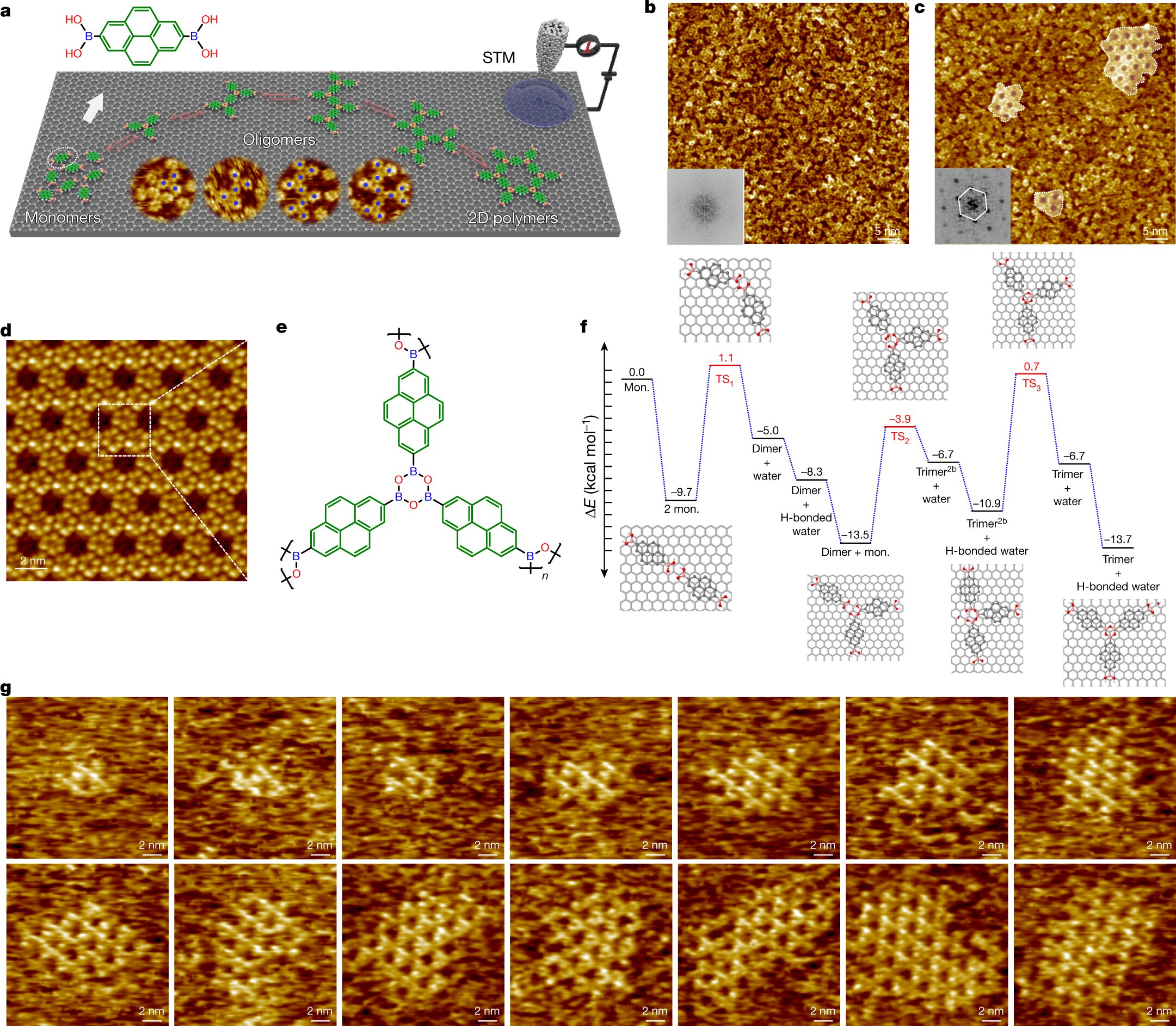
A team of researchers from KU Leuven, the University of Aveiro, OLYMAT, the University of the Basque Country UPV/EHU and the Ikerbasque, Basque Foundation for Science has used a scanning tunneling microscope (STM) to observe the formation of a 2D covalent polymer. In their paper published in the journal Nature, the group describes how they captured images of the stages involved in polymer development and then used simulations to complement the progression.
Microscopy unveils piece-by-piece formation of 2D covalent polymers
Highlight in Chemistry World.
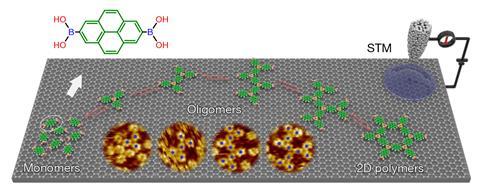
Using scanning tunnelling microscopy (STM), researchers have observed the piece-by-piece assembly of 2D dynamic covalent polymers – the basic building blocks of covalent organic frameworks (COFs). These detailed images will help understand complex growth mechanisms, potentially paving the way to tailored synthetic stacked structures.
Newly discovered ways to study meteorites may provide new understanding of the solar system
YouTube video.
IBM researchers Leo Gross and Katharina Kaiser, in collaboration with scientists at NASA and universities in Spain, France and Japan, used atomic force microscopy (AFM) to obtain the first ever atomic-resolution images of molecules of extraterrestrial origin. This research lays the groundwork for future discoveries of yet unknown molecules which could explain the mysteries around the formation of the solar system and the origin of life. The researchers used samples of the famous Murchison meteorite, provided by NASA, to image single organic molecules in their lab at IBM Research Europe - Zurich.
Voici les toutes premières images de molécules extraterrestres

Highlight in Le Parisien.
Jamais jusqu’ici on n’avait immortalisé des assemblages d’atomes venus de l’espace. A l’origine de cet événement inédit, révélé mardi, la rencontre entre des chercheurs français et une technologie de pointe.
Chemical ecosystem of Murchison meteorite molecules revealed in snapshots
Highlight in Chemistry World.
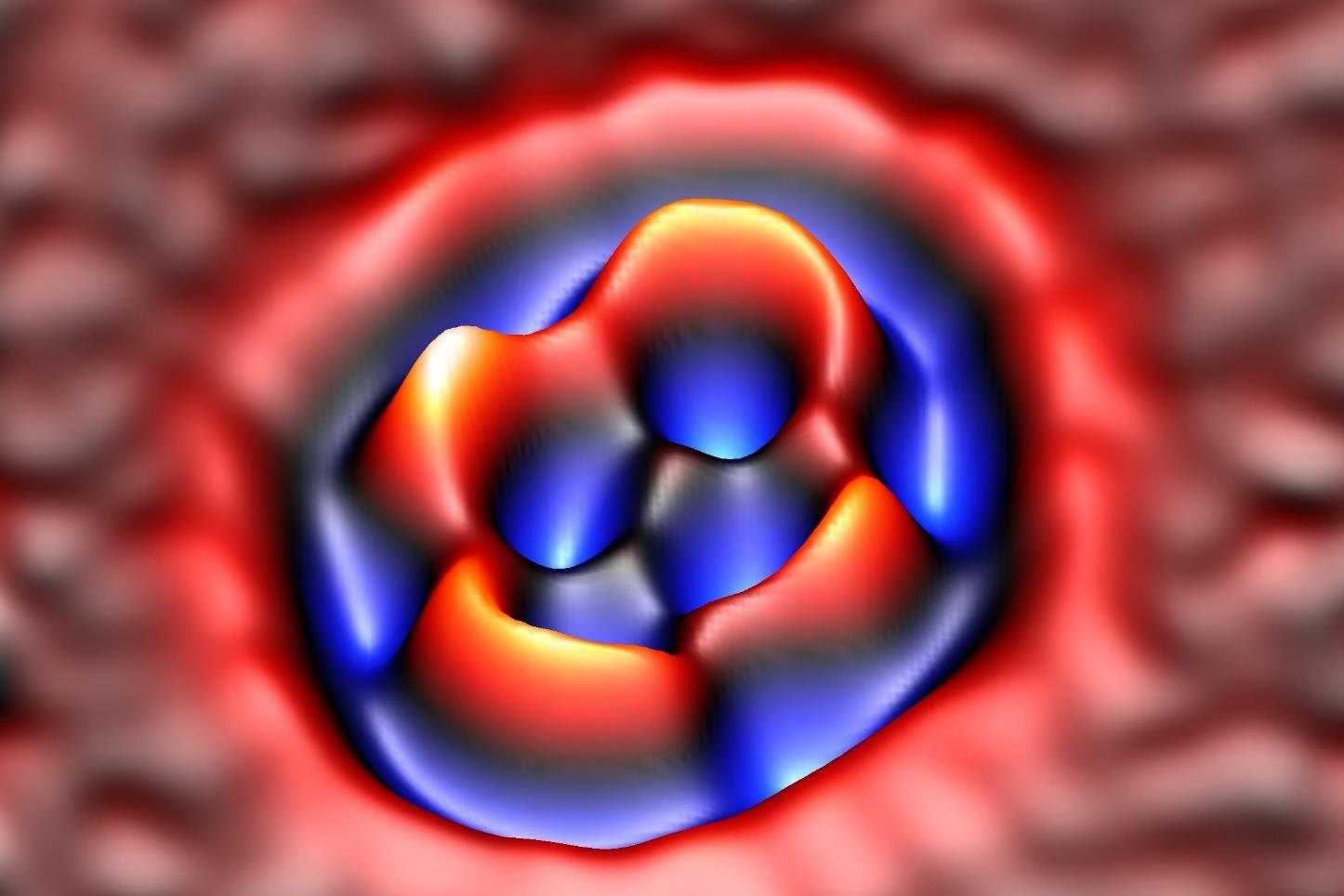
Pioneering AFM analysis has been used to further investigate the chemical diversity of the famous Murchison meteorite that exploded over Australia in 1969. It is hoped that the successful trial of this highly sensitive technique could lead to the discovery of new molecules in meteorites and samples from space missions.
Images of extraterrestrial molecules now on display
Highlight in C&EN.
![]()
AFM provides pictures of molecules from outer space for the first time.
The first atomic-resolution images of extraterrestrial molecules
Highlight in IBM Research Blog.
Meteorites are fragments of asteroids (and, potentially, comets) that reach the Earth’s surface intact. They’re leftovers from the solar system’s formation, providing clues to its history in the molecules they contain. Thanks to our latest research, published today in Meteoritics and Planetary Science, we can now read those clues a little better.
Viologen-Immobilized 2D Polymer Film Enabling Highly Efficient Electrochromic Device for Solar-Powered Smart Window
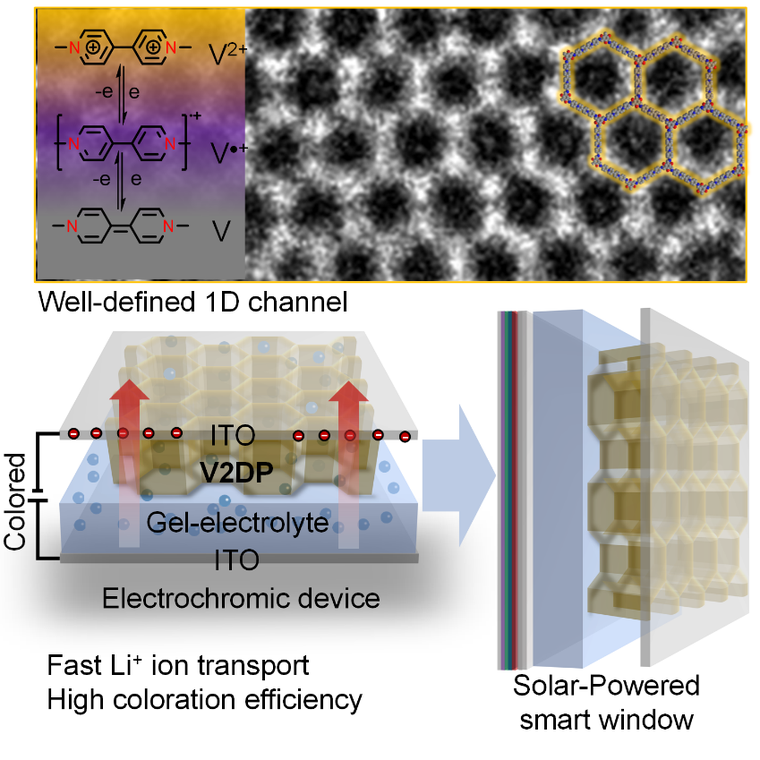
Two-dimensional polymers (2DPs) and their layer-stacked 2D covalent organic frameworks (2D COFs) are an emerging class of organic layered materials with well-defined permanent porosity. Thanks to their tailor-made structures and properties, these porous crystalline polymers have exhibited the potential for broad functions in optoelectronics, membrane, catalysis, and energy storage and conversion. Recent advances have demonstrated that 2D COFs integrated with color-switching, redox-active units such as triphenylamine in the backbones could present reversible color switching and are, therefore, excellent candidates for electrochromic devices (ECDs). Nevertheless, these 2D COF-based ECDs have not unleashed their full potential to display high coloration efficiency (CE) (while few examples could reach over 800 cm2 C−1) due to the random stacking of crystallites and the presence of amorphous defects that lead to restricted ion diffusion. In this regard, achieving related materials with highly ordered and oriented columnar-like pores could provide a large interface area with the electrolyte, high utilization of built-in color-switching components, and fast ion diffusion, which are crucial for realizing a quick and efficient EC switching.
New Path to Stable Nanographenes
ChemistryViews press release.

Peri-acenes with extended zigzag edges can have unique electronic and magnetic properties, but higher peri-acenes generally have poor ambient stability. The introduction of heteroatoms, such as boron or nitrogen (N), to the zigzag edges of peri-acenes can stabilize them thermodynamically.
NBN-Doped Bis-Tetracene and Peri-Tetracene: Synthesis and Characterization
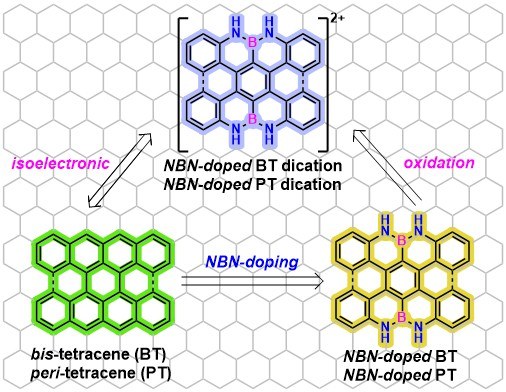
The zigzag-edge rich polycyclic aromatic hydrocarbons (PAHs), such as bis-tetracene and peri-tetracene, have attracted increasing attention due to their unique electronic and magnetic properties. However, the instability of bis-tetracene and peri-tetracene caused by the open-shell character limits their further investigations. Thus far, two main strategies, sterically blocking the most reactive position (kinetic stabilization) and heteroatom doping (thermodynamic stabilization), have been established to synthesize stable zigzag-edged higher acenes. Specifically, the introduction of heteroatoms such as boron (B) or nitrogen (N) on the zigzag edges, not only provides access to stable heteroatom-doped acenes but also offers the possibility to tune their electronic structures.
Interfacial Synthesis of Layer-Oriented 2D Conjugated Metal–Organic Framework Films toward Directional Charge Transport
TUD press release.
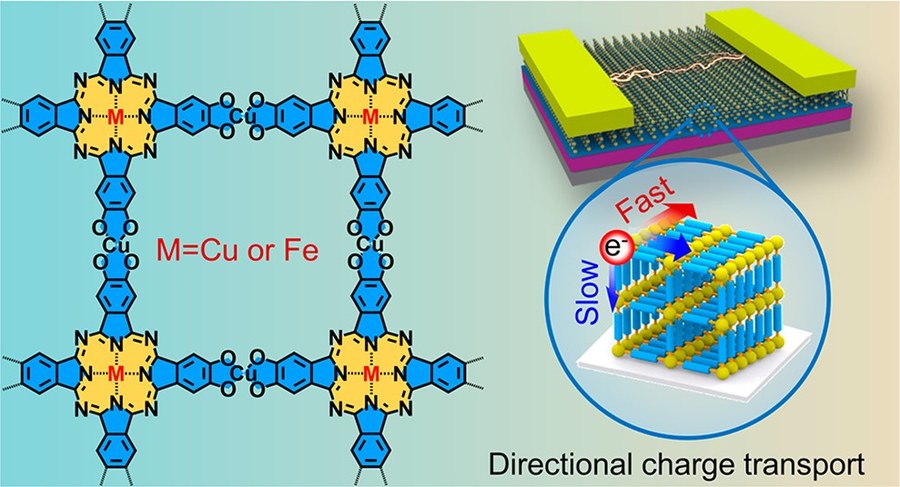
Two-dimensional conjugated metal-organic frameworks (2D c-MOFs) have emerged as a unique class of electronic materials, because they displayed the potential as active layers for electronic devices due to high conductivities (up to 2500 S cm-1) and high carrier mobilities (up to 220 cm2 V-1 s-1) with band-like transport property as well as tunable electronic structures. In the previous reports, a great effort was devoted to exploring electronic properties via the intralayer (basal plane) pathway because it was believed that the high conductivity of 2D c-MOFs depended critically on the full π-electron delocalization in the 2D conjugated plane. However, recent advances demonstrated that long-range charge transport in these layer-stacked framework materials could be primarily mediated via π–π stacking order. Therefore, controlled synthesis of layer-oriented 2D c-MOF films will be highly desirable to direct the charge transport along the interlayer or intralayer pathways and dial-in lateral/vertical electronic devices as well as further unveil the transport mechanism. Nevertheless, such investigations have never been addressed so far due to the challenge in controlling the stacking orientation of 2D c-MOFs in thin films.
Synthetic tuning of the quantum properties of open-shell radicaloids
TUD press release.
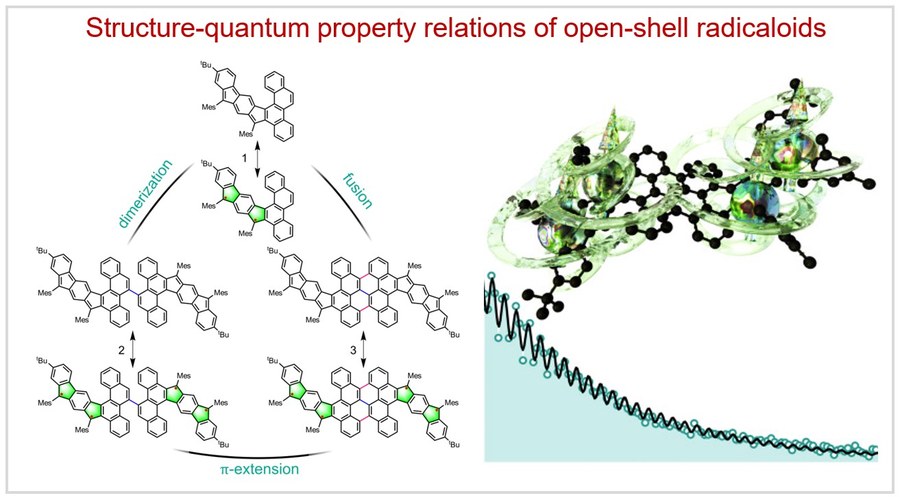
Molecular compounds are emerging as appealing units for quantum computation and quantum technologies. For these purposes open-shell molecular radicaloids hold exceptional interest: they offer π-conjugated units with an unpaired electron ground state and they can be considered as atomically-precise pieces of graphene. The next frontier to improve the quantum performance is to determine structure-quantum properties relations, such as how the size of the extended π-systems affects the coherence properties, or how the molecular geometry and electron-nuclear interactions determine the coherence time, so as to channel the synthetic efforts towards blocking decoherence pathways.
Workshop on “Exploitation of Results and IPR” held as part of ULTIMATE
Graphenea press release.

Last week Graphenea hosted a Virtual Workshop on “Exploitation of Results and IPR” as part of the ULTIMATE project. On day one of the workshop, Prof. Tomas Palacios of MIT explained how to manage intellectual property and perform business planning in nanoelectronics. Prof. Luigi Colombo of UT Dallas outlined the most common steps taken upon technology transfer in the semiconductor industry. On the second day, Dr. Helga Cester of Balder IP explained in detail what patentability is and how patenting works. Dr. Beatriz Alonso of Graphenea gave the industrial vision of the commercialization of graphene.
Vinylene-Linked Two-Dimensional Covalent Organic Frameworks: Synthesis and Functions
TUD press release.
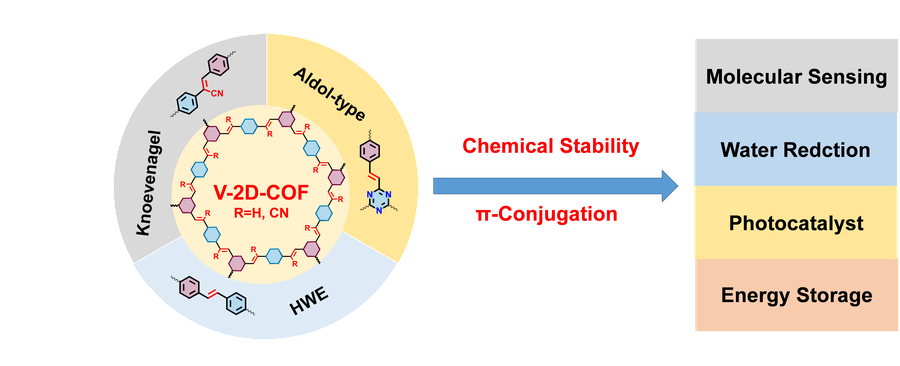
Two-dimensional conjugated covalent organic frameworks (2D-c-COFs) with covalently bonded repeat units, crystalline and porous frameworks, and in-plane π-conjugations have attracted immense attention. The precise structure and predictable properties of 2D-c-COFs can be applied to specific applications, such as energy storage/conversion, and optoelectronics. In particular, over the last five years, vinylene-linked 2D covalent organic frameworks (V-2D-COFs) have been extensively explored due to their high in-plane π-conjugation and robust nature.
High-Mobility Semiconducting Two-Dimensional Conjugated Covalent Organic Frameworks with p-Type Doping
TUD press release.

Two-dimensional conjugated covalent organic frameworks (2D c-COFs) have recently emerged as a unique class of 2D conjugated polymers that display high in-plane π-conjugation and weak out-of-plane interactions. Because of their tailorable architectures, abundant active sites, well-defined structures, inherent porosity, chemical stability, and (opto)-electronic properties, these materials are promising for chemiresistors, logic and memory devices, and energy storage. For many of these applications, long-range charge transport is required. Therefore, much effort has been devoted over the last years to interrogate the nature of the conductivity in 2D c-COFs. Recent studies have demonstrated charge carrier mobilities ranging from 5 to 8 cm2/(Vs). Although these mobilities are encouraging, their conductivities have remained rather low (typically <10-6 S/cm). To further improve the conductivity, doping strategies have been employed by incorporating guest molecules that act as dopants, e.g., linear conducting polymers, C60, iodine (I2), etc. For instance, I2-doping has demonstrated improvement of up to 3 orders of magnitude in the conductivities, but this approach was often associated with amorphization/irreversible structural changes of 2D c-COFs. A fundamental understanding of the doping interactions within the lattice in COFs remains largely unexplored.
Thiophene‐Bridged Donor–Acceptor sp2-Carbon-Linked 2D Conjugated Polymers as Photocathodes for Water Reduction
TUD press release.
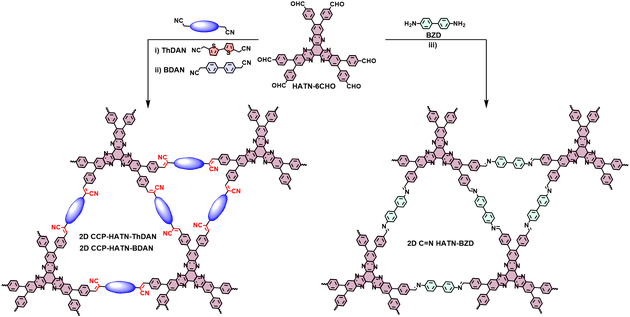
Photoelectrochemical (PEC) water reduction, converting solar energy into environmentally friendly hydrogen fuel, requires delicate design and synthesis of semiconductors with appropriate bandgaps, suitable energy levels of the frontier orbitals, and high intrinsic charge mobility. Two-dimensional covalent organic frameworks (2D COFs), which belong to the class of 2D conjugated polymers, have recently emerged as a promising class of materials for photocatalysis and PEC applications due to the tailored energy bandgaps, positions of the frontier orbitals, and active centers. However, traditional imine‐linked 2D COFs generally exhibit moderate electron delocalization and poor chemical stability, which hamper the potential implementation of these materials in PEC applications.
One-Pot Synthesis of Boron-Doped Polycyclic Aromatic Hydrocarbons via 1,4-Boron Migration
TUD press release.

Boron-doped polycyclic aromatic hydrocarbons (B-PAHs) are of great current interest due to their excellent photophysical properties and their promising applications in organic field-effect transistors (OFETs) and organic light-emitting diodes (OLEDs). Although significant efforts have been made in the past few years, the modular synthetic routes toward B-PAHs, particularly for dual-B doped PAHs, remain limited due to the intrinsic instability of B-PAHs against moisture and oxygen. So far, the existing methods for the synthesis of B-PAHs usually involve special precursor design or multiple synthetic steps, e.g., an additional oxidation etc., resulting in low overall yields of synthetic procedures. Thereby, it is highly attractive to develop cost-effective methodologies for the synthesis of B-PAHs from the readily available starting compounds.
A Curved Graphene Nanoribbon with Multi-Edge Structure and High Intrinsic Charge Carrier Mobility
TUD press release.
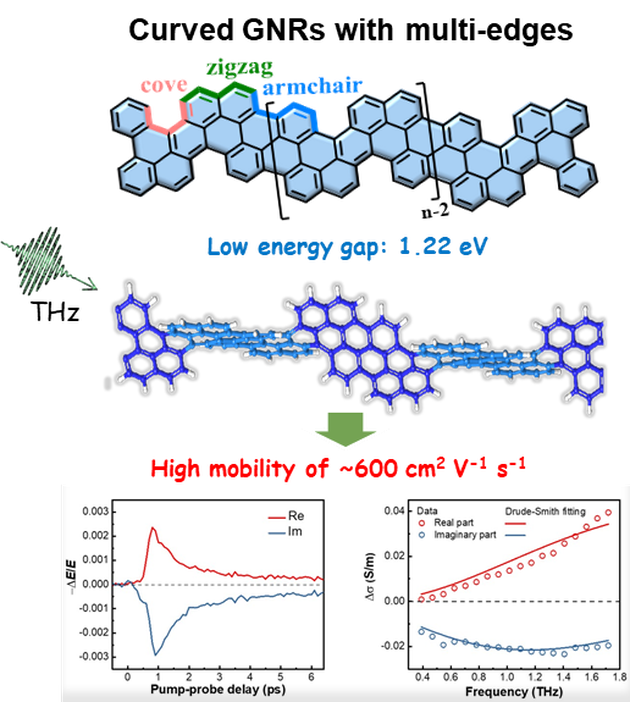
Both theoretical and experimental studies have demonstrated that the electronic and magnetic properties of GNRs are critically dependent on their widths and edge topologies. In contrast to armchair-edged GNRs (AGNRs) displaying semiconducting property with a direct energy gap, zigzag-edged GNRs (ZGNRs) typically exhibit narrow bandgaps and localized edge states. In addition, cove-edged GNRs with unique curved geometry are attractive because they can exhibit improved dispersibility in solution, and provide an additional means to control the optoelectronic properties of GNRs. Thereby, the combination of armchair, cove, and zigzag edge structures can impart GNRs with unique geometries and physiochemical properties that are not accessible by those with solely one type of edge structures.
Synthesis of Vinylene-Linked Two-Dimensional Conjugated Polymers via the Horner-Wadsworth-Emmons Reaction
TUD press release.
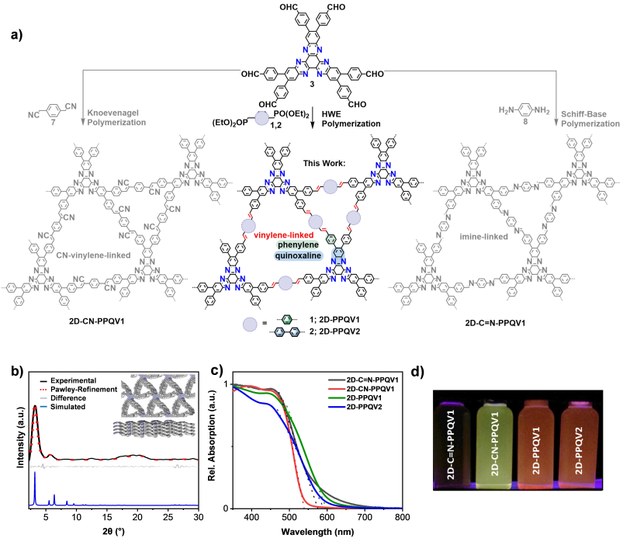
Interest in linear (1D) conjugated polymers has significantly increased in recent decades due to their semiconducting properties and promising applications in organic optoelectronics. 2D conjugated polymers (2D CPs) consisting of multi-strands of linear conjugated polymers have been the dream of synthetic targets for several decades. The synthesis of 2D CPs with fully vinylene-linked backbones still lacks effective protocols to generate crystalline polymer materials. Vinylene-linked 2D CPs provide high chemical and thermal stabilities as well as complete π-conjugation over the whole 2D polymer framework, making these materials highly attractive for various applications, such as in optoelectronics, spintronics, and energy storage.
Le graphène comme détective pour élucider l’auto-assemblage moléculaire
CNRS Alsace press release.
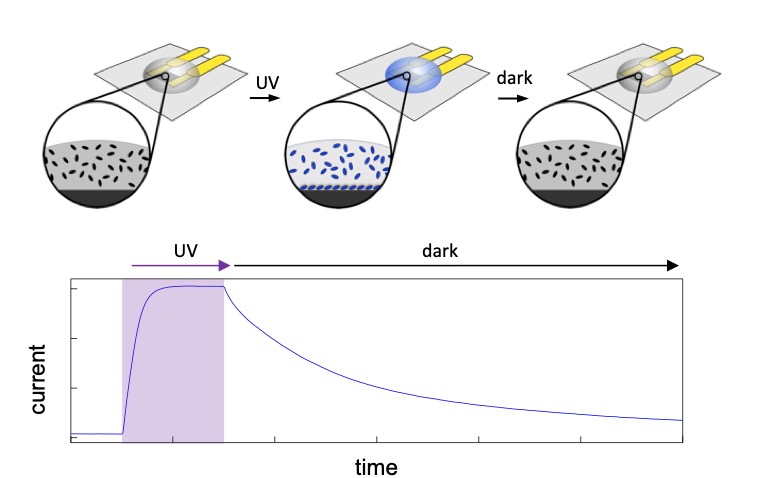
Des chercheurs du Laboratoire de nanochimie de l’Institut de science et d’ingénierie supramoléculaires (ISIS | CNRS Unistra), en collaboration avec l’Université Humboldt de Berlin et DWI – Institut Leibniz pour les matériaux interactifs/Université technique d’Aix-la-Chapelle (Allemagne), ont démontré que des dispositifs de graphène peuvent être utilisés pour suivre en temps réel la dynamique de l’auto-assemblage moléculaire à l’interface solide/liquide. Ces résultats ont été publiés dans la revue Nature.
Graphene as a detective to unravel molecular self-assembly
IRIS Adlershof press release.

Researchers from Humboldt-Universität zu Berlin, the DWI – Leibniz Institute for Interactive Materials, and RWTH Aachen University (Germany), in collaboration with the University of Strasbourg & CNRS (France), have demonstrated that graphene devices can be used to monitor in real time the dynamics of molecular self-assembly at the solid/liquid interface. Their results have been published in Nature Communications.
Le graphène comme détective pour élucider l’auto-assemblage moléculaire
UNISTRA press release.

Des chercheurs du Laboratoire de nanochimie de l’Institut de science et d’ingénierie supramoléculaires (Isis, Université de Strasbourg/CNRS), en collaboration avec l’Université Humboldt de Berlin et DWI-Institut Leibniz pour les matériaux interactifs/Université technique d’Aix-la-Chapelle (Allemagne), ont démontré que des dispositifs de graphène peuvent être utilisés pour suivre en temps réel la dynamique de l’auto-assemblage moléculaire à l’interface solide/liquide. Ces résultats ont été publiés dans la revue Nature Communications.
Graphene as a detective to unravel molecular self-assembly
ISIS press release.
 Researchers from the University of Strasbourg & CNRS (France), in collaboration with Humboldt University of Berlin and DWI – Leibniz Institute for Interactive Materials/RWTH Aachen University (Germany), have demonstrated that graphene devices can be used to monitor in real time the dynamics of molecular self-assembly at the solid/liquid interface. Their results have been published in Nature Communications.
Researchers from the University of Strasbourg & CNRS (France), in collaboration with Humboldt University of Berlin and DWI – Leibniz Institute for Interactive Materials/RWTH Aachen University (Germany), have demonstrated that graphene devices can be used to monitor in real time the dynamics of molecular self-assembly at the solid/liquid interface. Their results have been published in Nature Communications.
Le graphène comme détective pour élucider l’auto-assemblage moléculaire
ISIS press release.

Des chercheurs du Laboratoire de nanochimie de l’Institut de science et d’ingénierie supramoléculaires (Université de Strasbourg/CNRS), en collaboration avec l’Université Humboldt de Berlin et DWI – Institut Leibniz pour les matériaux interactifs/Université technique d’Aix-la-Chapelle (Allemagne), ont démontré que des dispositifs de graphène peuvent être utilisés pour suivre en temps réel la dynamique de l’auto-assemblage moléculaire à l’interface solide/liquide. Ces résultats ont été publiés dans la revue Nature Communications.
Graphene as a detective to unravel molecular self-assembly
Highlight in Nature Research Device & Materials Engineering Community.

Researchers from the University of Strasbourg & CNRS (France), in collaboration with Humboldt University of Berlin and DWI – Leibniz Institute for Interactive Materials/RWTH Aachen University (Germany), have demonstrated that graphene devices can be used to monitor in real time the dynamics of molecular self-assembly at the solid/liquid interface. Their results have been published in Nature Communications.
ULTIMATE-1st Progress Meeting & Workshop Hosted by TUD (Online Meeting)

On May 11th and 12th, the ULTIMATE-1st Progress Meeting & Workshop on how to overcome blackouts & scientific storytelling and ULTIMATE Early-Stage Researchers(ESR)’ presentation took place online, organized by ULTIMATE project and TU Dresden (Dr. Renhao Dong/Prof. Xinliang Feng/Prof. Gianaurelio Cuniberti).
Broad spectrum – Novel hybrid material proves an efficient photodetector
cfaed, HZDR, EurekAlert!, NWA, Phys.org and ScienceDaily press releases.
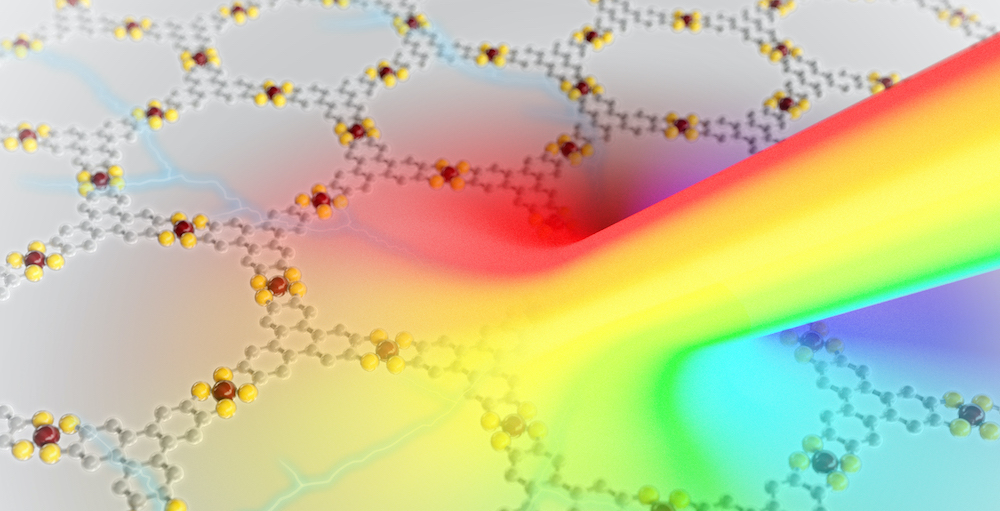
Digital cameras as well as many other electronic devices need light-sensitive sensors. In order to cater for the increasing demand for optoelectronic components of this kind, industry is searching for new semiconductor materials. They are not only supposed to cover a broad range of wavelengths but should also be inexpensive. A hybrid material, developed in Dresden, fulfils both these requirements. Himani Arora, a physics PhD student at Helmholtz-Zentrum Dresden-Rossendorf (HZDR), demonstrated that this metal-organic framework can be used as a broadband photodetector. As it does not contain any cost-intensive raw materials, it can be produced inexpensively in bulk.
Metal-organic semiconductor photodetector has 400 to 1575 nm spectral detection range
Laser Focus World press release.

To help satisfy the increasing demand for digital cameras and other optoelectronic components, industry is searching for new photodetecting semiconductor materials, which ideally should cover a broad range of wavelengths while being low in cost. A new hybrid material, developed at Helmholtz-Zentrum Dresden-Rossendorf (HZDR; Dresden, germany), fulfills both these requirements. Himani Arora, a physics PhD student, demonstrated that a metal-organic framework can be used as a broadband photodetector. As it does not contain any cost-intensive raw materials, it can be produced inexpensively in bulk.
MOF-based Broadband Photodetector
Optics & Photonics News press release.

Semiconductor photodetectors have found a home in devices large and small, ranging from the smartphone camera in your pocket to the imaging instrumentation on the Hubble Space Telescope. But the high costs of processing traditional semiconductor materials have led researchers to search for cheaper alternatives.
Novel Material for an Efficient Photodetector
PhotonicsViews press release.

In the last twenty years, metal-organic frameworks (MOFs) have become a coveted material system. So far, these highly porous substances, up to 90 percent of which are composed of empty space, have largely been used to store gases, for catalysis or to slowly release drugs in the human body. “The metal-organic framework compound developed at TU Dresden comprises an organic material integrated with iron ions,” explains Artur Erbe, head of the Transport in Nanostructures group at HZDR’s Institute of Ion Beam Physics and Materials Research. “The special thing about it is that the framework forms superimposed layers with semiconducting properties, which makes it potentially interesting for optoelectronic applications.” The group had the idea of using the new semiconducting two-dimensional MOF as a photodetector.
International Training Network „ULTIMATE“ starts
DWI press release.
The International Training Network "ULTIMATE", funded by the European Union, began its work with a kick-off meeting on 1 October. ULTIMATE stands for "Bottom-Up generation of atomicalLy precise syntheTIc 2D MATerials for high performance in energy and Electronic applications". The ULTIMATE network consists of universities and research institutes in eight European countries with a common goal: The promotion of young talents for strong research and development in the field of so-called synthetic 2-dimensional materials (S2DM) in Europe.
International Training Network „ULTIMATE“ geht an den Start
DWI press release.
Mit einem Kick-off Meeting hat am 1. Oktober das von der Europäischen Union geförderte International Training Network “ULTIMATE“ seine Arbeit aufgenommen. ULTIMATE steht für “Bottom-Up generation of atomicalLy precise syntheTIc 2D MATerials for high performance in energy and Electronic applications”. Das Netzwerk von ULTIMATE besteht aus Universitäten und Forschungsinstituten acht europäischer Länder, die ein gemeinsames Ziel haben: Die Förderung junger Talente für eine starke Forschung und Entwicklung im Bereich sogenannter synthetischer 2-dimensionaler-Materialien (S2DM) in Europa.
Ultimate, le réseau européen des jeunes talents de demain
UNISTRA press release.

Lancé le 1er octobre 2019 pour 4 ans, le réseau Ultimate rassemble différents partenaires européens parmi lesquels l’Université de Strasbourg. Objectif : faire éclore une nouvelle génération de leaders scientifiques en mesure de répondre à des enjeux sociétaux majeurs comme le bien-être, la santé et la sécurité des citoyens européens.
